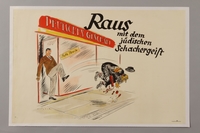Overview
- Brief Narrative
- German antisemitic propaganda poster encouraging Germans to fight against unfair Jewish business practices, by Philipp Rupprecht (Fips). The poster features a Jewish peddler banging his head in frustration when he sees storefront signs saying German businesses will no longer engage in Jewish haggling. The peddler has stereotypically exaggerated features: a long nose, a beard, red eyes, and heavyset. He is portrayed in shadowy, charcoal and black colors to emphasize the antisemitic trope of his untrustworthy nature, and to contrast the lighter colored, purer, Aryan storefront. The Nazis used propaganda to push the narrative that haggling Jewish peddlers were bad for German business and society. Nazi propaganda won the support of millions of Germans, affirmed Nazi ideas of racial superiority, and created an atmosphere that tolerated violence against Jews. They communicated their propaganda through art, music, film, radio, books, posters, and other published materials. Philipp Rupprecht, who used the penname Fips, was one of the Nazi’s preeminent propaganda creators. Rupprecht was an artist for Julius Streicher’s Der Stürmer, an antisemitic newspaper that prominently displayed Rupprecht’s work. His illustrations portrayed Jews as heartless and cruel, and featured discriminatory images of Jews with exaggerated facial features, and misshapen bodies. Rupprecht also illustrated the antisemitic children’s book Der Giftpilz (The Poisonous Mushroom).
- Title
- Schluss mit dem jüdischen Schachergeist!
- Alternate Title
- An end of Jewish Haggling
- Date
-
publication/distribution:
1936-1937
- Geography
-
publication:
Germany
- Credit Line
- United States Holocaust Memorial Museum Collection, Gift of the Alex and Boots Kertesz Family
- Markings
- front, top right, printed, gray ink : Schluss / mit / dem / jüdischen / Schachergeist [An end of Jewish haggling]
front, center, bottom, printed, black ink : So… war’s gemeint! [As it was meant to be!]
front, bottom, right corner, printed, black ink : WALDHEIM [W overtop horizontal E] EBERLE AG
front, center, within image, printed, red ink : ARISIERT [Aryanized]
front, center, within image, printed, black ink : FESTE / PREISE [firm prices]
front, center, within image, printed, red ink : Qualität [quality]
front, center, within image, printed, black ink : Deutsches / Geschäft German business]
front, center, within image, printed, black ink : HALT [stop]
front, center, within image, printed, black ink : Ramsch [junk] - Signature
- front, bottom right, black ink : Fips
- Contributor
-
Artist:
Fips
Subject: Fips
Publisher: Waldheim und Eberle
- Biography
-
Phillipp Rupprecht (1900-1975) was born in Nuremberg, Germany. He served in the German Navy during World War I. In 1920, he left Germany for Argentina, where he worked as a waiter and cowboy for several years. In the mid-1920s, he returned to Germany and worked as a cartoonist for the Fränkischen Tagespost, a Socialist newspaper. After drawing a cartoon of the Lord Mayor of Nuremberg, Hermann Luppe, Rupprecht was hired as an illustrator for the antisemitic newspaper Der Stürmer, by Julius Streicher, publisher of the paper and a regional leader of the Nazi party. While there, Rupprecht worked under the pen name Fips and became known for his variations on the antisemitic stereotype of the bearded, bulging eyed, large-nosed Jew. In 1938, he illustrated the antisemitic children's book, Der Giftpilz (The Poison Mushroom), published by the Stürmer publishing house. He joined the German Navy in 1939, but was released to create propaganda for the Nazi party. Rupprecht stayed at the paper until the last issue was published on February 22, 1945, and his career ended with the defeat of Germany in May. After the war, Rupprecht was captured by the United States Army and held in the 7th Army Internee Camp #74 in Ludwigsburg, Germany. He was put on trial as part of the de-Nazification process and sentenced to six years hard labor. Rupprecht was released from Eichstätt prison on October 23, 1950. He married twice, had four children, and worked in Munich as a painter and decorator until his death.
Physical Details
- Language
- German
- Classification
-
Posters
- Category
-
Anti-Jewish propaganda
- Object Type
-
Posters, German (lcsh)
- Genre/Form
- Posters.
- Physical Description
- Color, offset lithographic poster on off-white paper adhered to a linen backing. The poster depicts an image of a Jewish trader banging his head against a street signpost. The pole has a triangular sign with the word HALT, in black letters on a white background. The trader is stereotypically depicted with red eyes, a hooked nose, and darkly shaded. He is wearing a black coat with a black fedora style hat, has charcoal colored skin and carries a black box in his hands. Falling out of the box are various small goods. Four small Stars of David rise from the impact of his head hitting the pole, and his hat has been thrown into the air by the force of the movement. In front of him, across the street is a light red, pastel-colored storefront with several signs advertising fair priced, German quality goods. The artist signature and publisher name are both in the bottom right corner.
- Dimensions
- overall: Height: 51.000 inches (129.54 cm) | Width: 38.375 inches (97.473 cm)
- Materials
- overall : paper, ink, adhesive, linen
Rights & Restrictions
- Conditions on Access
- No restrictions on access
- Conditions on Use
- No restrictions on use
Keywords & Subjects
Administrative Notes
- Legal Status
- Permanent Collection
- Provenance
- The poster was donated to the United States Holocaust Memorial Museum in 1993 by Alex Kertesz.
- Funding Note
- The cataloging of this artifact has been supported by a grant from the Conference on Jewish Material Claims Against Germany.
- Record last modified:
- 2022-07-28 17:51:37
- This page:
- https://collections.ushmm.org/search/catalog/irn8220
Download & Licensing
In-Person Research
- By Appointment
- Request 21 Days in Advance of Visit
- Plan a Research Visit
- Request to See This Object
Contact Us
Also in Alex and Boots Kertesz family collection
The collection consists of five antisemitic posters published in Nazi Germany.
Date: 1936-1937

Antisemitic broadside by Fips claiming German business and Jews are incompatible
Object
German antisemitic propaganda poster featuring sales tags encouraging Germans to fight against unfair Jewish business practices, designed by Philipp Rupprecht (Fips). The Nazis used propaganda to push the narrative that Jewish greed was a burden to society. The poster uses the antisemitic trope of the Jewish usurer; a moneylender who charges excessive interest, which originated from the Middle Ages. In many areas of medieval Europe, Jews were barred from many occupations and from owning land. In turn, they had to rely on interest from moneylending to earn income. During this time, the Catholic Church regarded moneylending for interest as immoral, and prohibited Catholics from the practice. Because of this stigma, Jewish moneylenders were seen as immoral and predatory by their Catholic counterparts. These ideas evolved into the antisemitic concept of the fraudulent, parasitic, Jewish businessman who worshipped money. Nazi propaganda used this trope to promote the narrative that Jews were bad for German (Aryan) business and created an atmosphere that tolerated violence against Jews. The Nazis communicated their propaganda through art, music, film, radio, books, posters, and other published materials. Philipp Rupprecht, who used the pen name Fips, was one of the Nazi’s preeminent propaganda creators. Rupprecht was an artist for Julius Streicher’s Der Stürmer, an antisemitic newspaper that prominently displayed Rupprecht’s work. His illustrations portrayed Jews as heartless and cruel, and featured discriminatory images of Jews with exaggerated facial features, and misshapen bodies. Rupprecht also illustrated the antisemitic children’s book Der Giftpilz (The Poisonous Mushroom).

Antisemitic poster by Mjölnir depicting a German store owner kicking out a Jewish trader
Object
German antisemitic propaganda poster encouraging Germans to fight against unfair Jewish business practices, designed by Hans Schweitzer (Mjőlnir). The poster features an image of an Aryan businessman standing in the doorway of a storefront called “German Business” who has just kicked out a Jewish peddler, symbolizing that German businesses will longer deal with Jews. The peddler is dressed all in black with a stereotypical dark and curly beard, payot, and a hooked nose. He is portrayed with yellow skin, a symbol of cowardice, betrayal, and ill health, to emphasize the antisemitic trope of his untrustworthy nature. The Nazis used propaganda to push the narrative that haggling Jewish traders were bad for German business and society. Nazi propaganda won the support of millions of Germans, affirmed Nazi ideas of racial superiority, and created an atmosphere that tolerated violence against Jews. They communicated their propaganda through art, music, film, radio, books, posters, and other published materials. Hans Schweitzer, who used the pen name Mjőlnir, was friends with Reich Minister of Public Enlightenment and Propaganda, Joseph Goebbels, and created many posters for the Nazi Party. In 1935, he was appointed as Representative for Artistic Design and worked in conjunction with the Ministry of Propaganda for the creation of exhibitions, erection of monuments, and the development of insignia and national symbols. Later he worked with a commission to decide how to utilize artwork stolen from Nazi victims.

Antisemitic poster by Fips urging Germans to fight Jewish overpricing
Object
German antisemitic propaganda poster encouraging Germans to fight against unfair Jewish business practices, designed by Philipp Rupprecht (Fips). The poster features a German businessman with a Jewish money lender (that he likely owes money to) on his mind. The Nazis used propaganda to push the narrative that Jewish greed was a burden to society. The image uses the antisemitic trope of the Jewish usurer; a moneylender who charges excessive interest, which originated in the Middle Ages. In many areas of medieval Europe, Jews were barred from many occupations and from owning land. In turn, they had to rely on interest from moneylending to earn income. During this time, the Catholic Church regarded moneylending for interest as immoral, and prohibited Catholics from the practice. Because of this stigma, Jewish moneylenders were seen as immoral and predatory by their Catholic counterparts. These ideas evolved into the antisemitic concept of the fraudulent, parasitic, Jewish businessman who worshipped money. Nazi propaganda used this trope to promote the narrative that Jews were bad for German (Aryan) business and created an atmosphere that tolerated violence against Jews. The Nazis communicated their propaganda through art, music, film, radio, books, posters, and other published materials. Philipp Rupprecht, who used the penname Fips, was one of the Nazi’s preeminent propaganda creators. Rupprecht was an artist for Julius Streicher’s Der Stürmer, an antisemitic newspaper that prominently displayed Rupprecht’s work. His illustrations portrayed Jews as heartless and cruel, and featured discriminatory images of Jews with exaggerated facial features, and misshapen bodies. Rupprecht also illustrated the antisemitic children’s book Der Giftpilz (The Poisonous Mushroom).

Antisemitic poster by Fips depicting a German shop being cheated by Jewish businessmen
Object
German antisemitic propaganda poster encouraging Germans to fight against unfair Jewish business practices, by Philipp Rupprecht (Fips). The poster features two heavyset Jewish businessmen at the entrance of a German store. As one enters, the other one exits, in an apparent attempt to swindle money or goods from the store. The image implies the antisemitic trope of the fraudulent, parasitic, Jewish businessman who worships money, and uses it to push the narrative that Jewish greed was a burden to society and German (Aryan) business. Nazi propaganda was used to win the support of millions of Germans, affirm Nazi ideas of racial superiority, and create an atmosphere that tolerated violence against Jews. They communicated their propaganda through art, music, film, radio, books, posters, and other published materials. Philipp Rupprecht, who used the penname Fips, was one of the Nazi’s preeminent propaganda creators. Rupprecht was an artist for Julius Streicher’s Der Stürmer, an antisemitic newspaper that prominently displayed Rupprecht’s work. His illustrations portrayed Jews as heartless and cruel, and featured discriminatory images of Jews with exaggerated facial features, and misshapen bodies. Rupprecht also illustrated the antisemitic children’s book Der Giftpilz (The Poisonous Mushroom).



